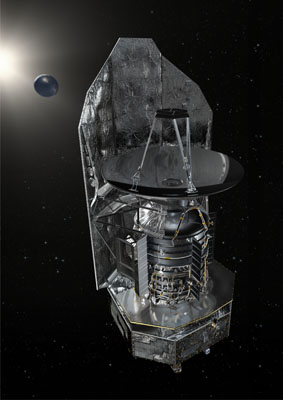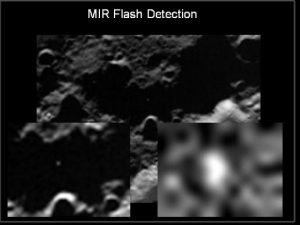Update from ESA: This is the final decision taken by ESA management after a careful evaluation of the cost and benefits of such a use of the spacecraft in early 2013, when Herschel will run out of helium and the mission will come to an end. The Herschel spacecraft will instead be “parked” indefinitely in a heliocentric orbit. More info on the Herschel Science Centre website.

Herschel will run out of its helium coolant at some point in the first half of 2013, after which the mission will be over. There is much debate about what to do with the spacecraft after that. One suggestion is to fly Herschel into the Moon, creating a fresh impact crater and allowing astronomers to search for further signs of water.
Once the helium coolant has run out, none of the the instruments on board will work, but the spacecraft itself will still be fully functional. There will be a few engineering tasks to complete, but after that the scientific mission of the spacecraft will be done. It won’t be a complete derelict however: there will still be the on-board computers, the thrusters, the communications equipment, and the “Space Radiation Environment Monitor” – which measures high-energy particles coming from the Sun and other astrophysical phenomena.
Herschel has on board a number of thrusters, which it fires every month or so to keep it in its orbit around L2, a point in space 1.5 million km from Earth in the opposite direction to the Sun. The thrusters are not particularly powerful, but they are crucial – if the orbital maintenance manoeuvres weren’t done, Herschel’s orbit would become unstable and it would drift onto an unknown trajectory. While the risk is low, this unknown trajectory could cause it to return to the Earth in the future, possibly causing damage either on the ground or to orbiting satellites and spacecraft.
It’s a problem that the European Space Agency are well aware of. Göran Pilbratt, Herschel’s Project Scientist, told Spaceflight Now “When the coolant is gone, then Herschel is useless as an astronomical facility. The spacecraft needs to be put somewhere for posterity – you don’t want it to come hitting our heads”.

The solution envisaged at the start of the mission was to fire Herschel’s thrusters to place in a stable orbit around the Sun, which would remove the risk of it causing damage for at least a few hundred years. This would allow the spacecraft to be retrieved many years in the future, though some argue that it would be so out of date by then that. A research team, coordinated by Neil Bowles from Oxford University, has proposed a more permanent solution – to put Herschel on a collision course with the Moon.
This might sound more risky than the current plan, but in fact the spacecraft could be targeted at an area the size of a football stadium. Herschel’s thrusters would not cause it to travel very quickly, and it would take severl months to reach the Moon. As it nears the Moon, the spacecraft would be accelerated by the pull of the Moon’s gravity, and the 3-tonne spacecraft would impact at a speed of around 5500 mph. This would give it enough speed to excavate a crater 30 metres wide and 5 metres deep – large enough to be seen by spacecraft currently in orbit around the Moon.

The purpose of doing this would be to try to find water under the Moon’s surface. The Moon used be thought to be a completely dry place. But parts of the lunar surface, particulary in deep craters near the Moon’s poles, are never exposed to sunlight, and it is thought that water ice could be trapped beneath the surface, at depths up to a few metres. It’s something that has be tried before, notably by NASA’s LCROSS mission which crashed a rocket stage – which had a slightly lower mass than Herschel – into the crater Cabeus near the Lunar south pole. The trailing spacecraft took images of a plume of material that rose several miles high, and identified the presence of water – though only in this one location on the Moon.
The presence of water ice on the lunar surface could have an impact on future manned bases, not least because water can be used to generate fuel for rockets and spacecraft. Neil Bowles, a planetary scientist at Oxford University who is coordinating lunar impact proposal, pointed out that “It is certainly lower than the cost of a purpose built mission with similar science goals.”
There are mixed reactions amongst the Herschel team. Some object on emotional grounds, while others are all for it. Matt Griffin, from Cardiff University and lead scientist of the SPIRE Instrument, commented that it’s “better to go out in a blaze of glory and do some more science as we do so!”
The decision will be made by ESA in the coming months, but the research team are already picking possible locations. One question will still remain however: there’s already a crater on the Moon called Herschel, so what will we call the new one?
You can see more information at a Spaceflight Now article, and on the “Herschel’s Last Year” Blog
